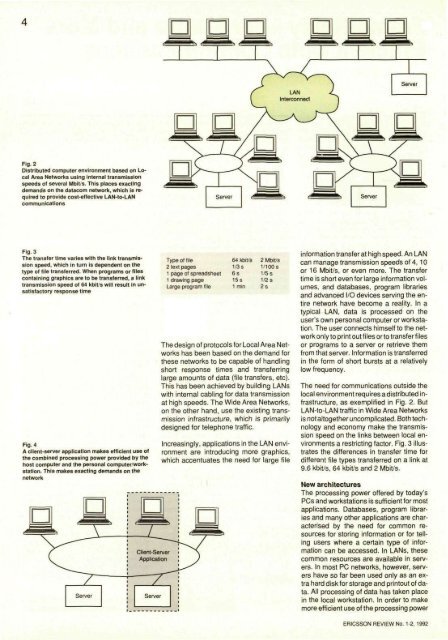Frame Relay - for Faster and More Efficient Data Communications ...
Frame Relay - for Faster and More Efficient Data Communications ...
Frame Relay - for Faster and More Efficient Data Communications ...
- No tags were found...
You also want an ePaper? Increase the reach of your titles
YUMPU automatically turns print PDFs into web optimized ePapers that Google loves.
4Fig. 2Distributed computer environment based on LocalArea Networks using internal transmissionspeeds of several Mbit/s. This places exactingdem<strong>and</strong>s on the datacom network, which is requiredto provide cost-effective LAN-to-LANcommunicationsFig. 3The transfer time varies with the link transmissionspeed, which in turn is dependent on thetype of file transferred. When programs or filescontaining graphics are to be transferred, a linktransmission speed of 64 kbit/s will result in unsatisfactoryresponse timeFig. 4A client-server application makes efficient use ofthe combined processing power provided by thehost computer <strong>and</strong> the personal computer/workstation.This makes exacting dem<strong>and</strong>s on thenetworkType of file 64 kbit's 2 Mbit*2 text pages 1/3s 1/100 s1 page of spreadsheet 6 s 1/5 s1 drawing page 15 s 1/2 sLarge program file 1 min 2 sThe design of protocols <strong>for</strong> Local Area Networkshas been based on the dem<strong>and</strong> <strong>for</strong>these networks to be capable of h<strong>and</strong>lingshort response times <strong>and</strong> transferringlarge amounts of data (file transfers, etc).This has been achieved by building LANswith internal cabling <strong>for</strong> data transmissionat high speeds. The Wide Area Networks,on the other h<strong>and</strong>, use the existing transmissioninfrastructure, which is primarilydesigned <strong>for</strong> telephone traffic.Increasingly, applications in the LAN environmentare introducing more graphics,which accentuates the need <strong>for</strong> large filein<strong>for</strong>mation transfer at high speed. An LANcan manage transmission speeds of 4,10or 16 Mbit/s, or even more. The transfertime is short even <strong>for</strong> large in<strong>for</strong>mation volumes,<strong>and</strong> databases, program libraries<strong>and</strong> advanced I/O devices serving the entirenetwork have become a reality. In atypical LAN, data is processed on theuser's own personal computer or workstation.The user connects himself to the networkonly to print out files or to transfer filesor programs to a server or retrieve themfrom that server. In<strong>for</strong>mation is transferredin the <strong>for</strong>m of short bursts at a relativelylow frequency.The need <strong>for</strong> communications outside thelocal environment requires adistributed infrastructure,as exemplified in Fig. 2. ButLAN-to-LAN traffic in Wide Area Networksis not altogether uncomplicated. Both technology<strong>and</strong> economy make the transmissionspeed on the links between local environmentsa restricting factor. Fig. 3 illustratesthe differences in transfer time <strong>for</strong>different file types transferred on a link at9.6 kbit/s, 64 kbit/s <strong>and</strong> 2 Mbit/s.New architecturesThe processing power offered by today'sPCs <strong>and</strong> workstations is sufficient <strong>for</strong> mostapplications. <strong>Data</strong>bases, program libraries<strong>and</strong> many other applications are characterisedby the need <strong>for</strong> common resources<strong>for</strong> storing in<strong>for</strong>mation or <strong>for</strong> tellingusers where a certain type of in<strong>for</strong>mationcan be accessed. In LANs, thesecommon resources are available in servers.In most PC networks, however, servershave so far been used only as an extrahard disk <strong>for</strong> storage <strong>and</strong> printout of data.All processing of data has taken placein the local workstation. In order to makemore efficient use of the processing powerERICSSON REVIEW No. 1-2, 1992















